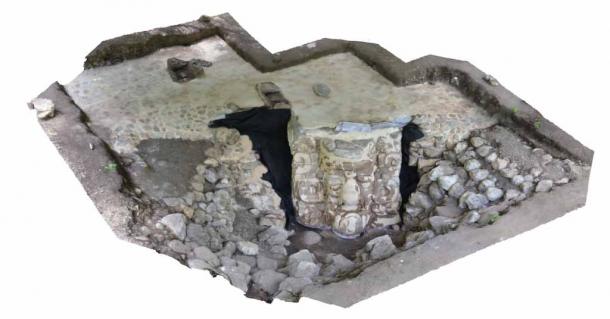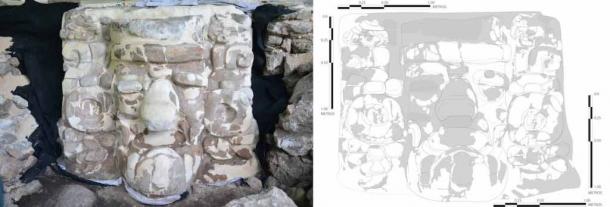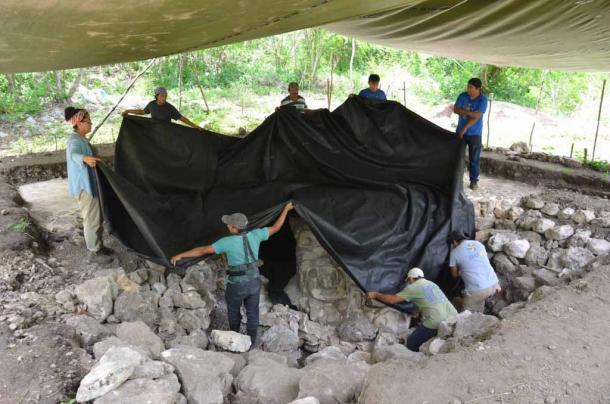In the southeastern Mexican state of Yucatán on the Yucatán Peninsula, an archaeological team digging at a lightly explored site near the tiny, picturesque village of Ucanha uncovered something highly unusual. It was a giant human-looking face, as tall as a person and sculpted in stucco. Its features clearly identified it as a Mayan mask of the ancient Maya civilization , which enjoyed total hegemony in this part of the world more than one thousand years ago.
Mayan Mask Discovered in the Yucatán Peninsula
The Maya stucco relief was first discovered in 2017. Researchers from the National Institute of Anthropology and History (INAH) in Mexico spent three years carefully restoring the sculpture, between periods when it was temporarily reburied to prevent its rapid deterioration from exposure to the elements. They were able to positively date the Mayan mask to the Late Pre-Classical era of the ancient Maya civilization, meaning it was created sometime between 300 BC and 250 AD.

View of the giant stucco face, or Mayan mask, in situ. The face was discovered in the Yucatán Peninsula near the village of Ucanha. ( INAH)
In their statement announcing the finding , INAH stated that sculptures like these “represent the faces of individuals with particular features that can be associated with deities or with characters of prominent social status.” It was a common practice in Maya civilization to decorate buildings with large-scale, embedded decorative sculptures, which often featured the faces of rulers or gods.
Relics like this are a rare find, however, since so many of the sculptures that once existed have been irrevocably damaged, or destroyed, or remain deeply buried in undiscovered locations. Nevertheless, similar sculpted stucco reliefs have been found in the villages of Acanceh and Izamal. But those are the only other giant faces discovered on the Yucatán Peninsula.
Recognizing the delicate nature of their discovery, the archaeologists have now reburied the fully-restored sculpture, thereby guaranteeing its preservation. However, tourists interested in getting a closer look at ancient Maya stucco reliefs can do so by traveling to Acanceh . There, several sculptures honoring Maya deities have been put on display to the public, in the town’s “Palace of the Stuccos.”

Detail of the stucco Mayan mask discovered near the village of Ucanha in Mexico. ( INAH)
Olmec Influence on the Maya
The giant stucco Mayan mask represents outstanding examples of ancient Maya art . Maya gods and rulers were routinely honored in sculpted form, and in addition to stucco, Maya artists also sculpted in stone, wood, bone, shells, and fired clay. The Maya interest in creating human-like sculpted faces dates back to the first millennium BC. Their artistic endeavors in this area were clearly influenced by their contacts with the Olmecs, the so-called “ Mother Culture of Mesoamerica ” that occupied the expansive land regions to the west of the Yucatán Peninsula until around 400 BC, when their societies vanished for reasons undetermined.
Little is known about the nature of the contacts between the Olmecs and the Maya. But Olmec influence on Maya culture was profound. The Olmecs affected the Maya people’s spiritual beliefs, practices and even their recreational activities, as well as their preferences in artistic style and architecture.
The Olmecs are best known today for their colossal carved stone head statues , which weigh several tons each and are believed to represent the visages of revered Olmec rulers. The carved faces in these gigantic chunks of rock are reminiscent of the Mayan masks and giant faces created by Maya sculptors, who would have been commissioned to make these works of art by rulers in the various small kingdoms that comprised the greater Maya civilization.
In the late Pre-Classical era, when the giant face at Ucanha was sculpted, the Maya were living in still small but increasingly populated agricultural villages. These rapidly expanding settlements formed the seeds of the great Maya cities that arose to dominate the region in the Classical era, which ran from 250 AD to 900 AD.
Larger-than-life artistic creations like the giant face of Ucanha are reflections of a society that was becoming increasingly confident and ambitious. At the height of their power, the Maya exercised political, cultural, and social control over a wide swath of southern Mexico and Central America. They were able to maintain that control for several centuries, before internal decay followed by Spanish conquest brought about the demise of their kingdoms.

Recognizing the sensitive nature of their discovery, the archaeologists have now reburied the fully-restored sculpture, thereby guaranteeing its preservation. (INAH)
Exploring History Through Artifacts Left Behind: The Mayan Mask
While the Maya people are still around in significant numbers, the great cultures built by their distant ancestors exist only in the form of the artifacts, relics, and architectural masterpieces they left behind. Amazing discoveries like the giant face at Ucanha don’t reveal many details about the culture or artists that created them. But they do act as markers of the ongoing cultural evolution that was changing Maya society , taking them away from their modest agrarian roots and transforming them into a diversified, ambitious, and highly successful urban culture, one which was ultimately doomed to extinction, as all great civilizations and empires seem to be.
Of course, what the Maya experienced during the transition from the Pre-Classical to the Classical era is the same type of evolutionary transformation that has been experienced in Europe, the United States, and elsewhere across the planet over the past two centuries. When archaeologists from the far future are digging through the rubble left behind following our final collapse, they will likely be just as curious about the long-lost civilization that created the giant carved heads at Mount Rushmore as we are about the long-lost civilization that created the giant sculpted faces on the Yucatán Peninsula.
Top image: Mayan mask made of stucco which was discovered in the Yucatán Peninsula in Mexico. Source: INAH
By Nathan Falde
Related posts:
Views: 0
 RSS Feed
RSS Feed

















 January 27th, 2021
January 27th, 2021  Awake Goy
Awake Goy  Posted in
Posted in  Tags:
Tags: 
















